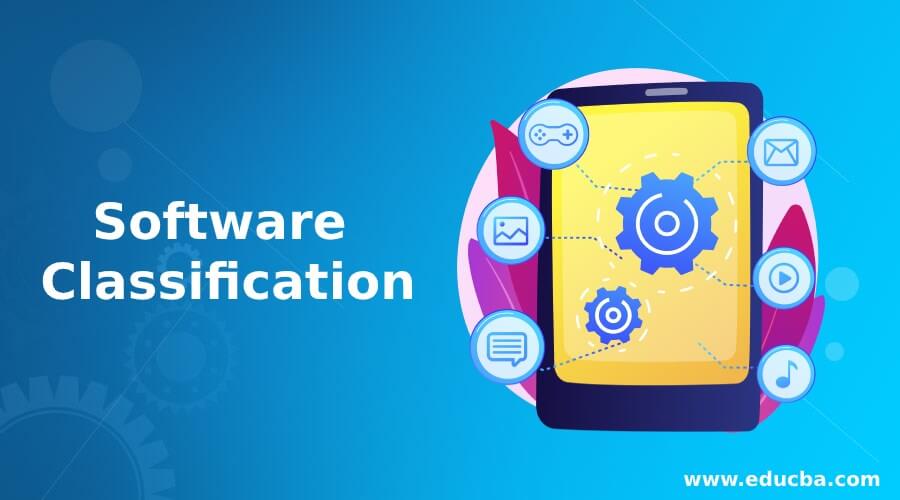Updated July 5, 2023
Introduction of Software Classification
Software is a code or a set of instructions that tells a computer or hardware how to operate. Software is usually generic, but it can also be custom-built. Generic software is open to the market, and the programmer designs its specifications. They are mainly designed for a broad customer market. Customized software is software whose specifications are designed according to a particular firm or organization. It is not an operator at all. They are mainly designed for specific business purposes. Software is mainly classified into seven categories – System software, Application software, Engineering/scientific software, embedded software, Product line software, Web applications, and Artificial intelligence software.
Classification of Software
In this section, we will discuss the various classification of software in detail.
1. System Software
It directly interacts with computer hardware. It is primarily concerned with the efficient management of the computer system. Developers use it to develop new system programs, and they can make them portable using bootstrapping. It is machine dependent. The system software is further classified into three categories – The operating system, which acts as an interface between the User and the hardware and provides different services to users. The second one is system support software which manages the hardware more efficiently. The other is System development software which supports a programming development environment for the User.
2. Application Software
The software is designed to solve user problems according to their requirements. Application software can be generic or customized. We further classify application software into two categories – one is general-purpose software that users utilize for a wide range of tasks and provides numerous features. Another type of software is special-purpose software, specifically designed for a particular purpose. For example, User’s programs. The focus is on the application, not on the computer system. It is primarily concerned with the solution of some problems using the computer as a tool.
3. Engineering/Scientific Software
It deals with processing requirements in a specific application. Users specially use this software for drawing, modeling, drafting, load calculations, and analyzing engineering and statistical data for interpretation and decision-making. For example, CAD (Computer Aided Design), CAM (Computer Aided Manufacturing), and CAE (Computer Aided Engineering). Users utilize this software in mechanical, electrical, drafting, engineering, and analysis. They run on mainframes, general-purpose workstations, and PCs (Personal computers).
4. Embedded Software
Developers embed this software into hardware as a part of larger systems to control their various functions. The systems’ ROM (Read Only Memory) embeds this type of software. For example, Keypad control software embedded in a microwave oven or washing machine where there is a need to take input, analyze and decide and take action, which allows the product to perform in the desired manner. People also refer to this software as intelligent software because of its performance.
5. Product Line Software
This type of software refers to software engineering methods, tools, and techniques for creating a collection of similar software systems from a shared set of software assets using a standard means of production. It is a set of software products that share standard features but differ from each other in some way. For example, a specific customer or embedded software (Word document, spreadsheet, computer graphics, personal and business applications) may develop them.
6. Web Applications
Users access it as an application via web browsers over a network such as the Internet or an intranet. It is also a computer software application that developers code in a browser support language and that relies on a common web browser to render the application executable. The first generation of web applications allows the business to post the information publicly. Thus, anyone with a web browser and internet access can see this information. The problem with the first generation is that the information is in static form. The second-generation web applications allow users to do interactive queries against databases from a web application.
It facilitates communication, information sharing, user-centered, and collaboration on the WWW. The third generation is more valuable than the second generation application. In combination with queries of the second-generation application and static information of the first generation, the third generation is a powerful business tool for organizations in their electronic commerce efforts.
7. Artificial Intelligence Software
This software uses non-numerical algorithms that use the data generated in the system to solve complex problems that are not amenable to problem-solving procedures and require specific Analysis and interpretation of the problem to solve it. For example, Artificial neural networks, robotics, expert systems, and computer games. All this software can run either in real-time mode or offline mode. Users can share these software programs free of charge through storage.
Recommended Articles
This is a guide to Software Classification. Here we also discuss the introduction and various classifications of software along with a detailed explanation. You may also have a look at the following articles to learn more –



